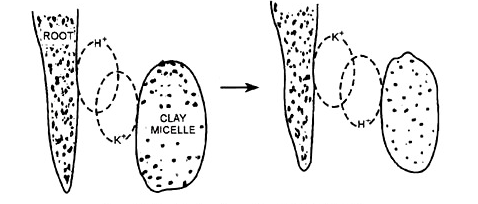Ion Uptake Mechanism (Contact exchange theory, CO2 exchange theory)
Ion Uptake Theory
Scientists have postulated many theories about adsorption of ions, among them following 2 are most important
1. Contact exchange theory.
2. CO2 exchange theory.
1. Contact exchange theory
 |
| Contact exchange theory |
In 1951 aenni and his associates develop this theory. This is a process of direct ion exchange between root cells and soil colloids. They observe that cations of soil colloids are generally moving around their own shell and similarly H+ ions of root surface are also moving around their own shell. In this process, once upon a time when two shells are come in contact closely they overlap each other. Then the ions of these two shells, exchange each other. Result by, H+ ions are replaced by other cations.
H+ [Root] + K+ [Clay] → K+ [Root] + H+ [Clay].
2. CO2 exchange theory
Walker 1960 differed with Gennis contact exchange theory. According to his theory, he says, plant roots uptake cation and anion in the exchange of H+ and OH-ions from soil solution respectively. The following steps are associated with CO2 exchange theory.
Step1: After respiration of plant roots and soil micro organism CO2 is produced. By the reaction of CO2 with H2O, H2CO3 acid is produced.
Step2:By the dissociation of H2CO3 acid ions pairs of H+ and HCO3 are produced and these ion pairs transfer/ locate into a clay surface area of long distance.
Step3:Cations like K+ is replaced by H+ from clay surface and produce the ion pairs HCO3 and K+ and the clay particles become acidic.
Step- 4 :These new ion pairs return to the surface of root which is easily available for plants.
Step-5 :K+ or HCO3 both enter into the plant roots with the exchange of H+ of root surface area.
You can read more articles about Agricultural Chemistry
Important Agricultural Websites
